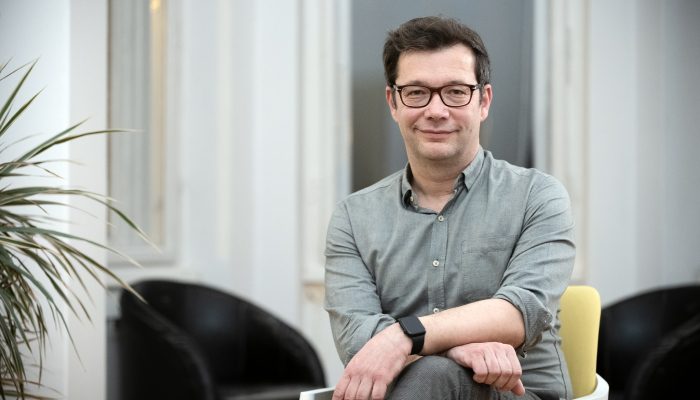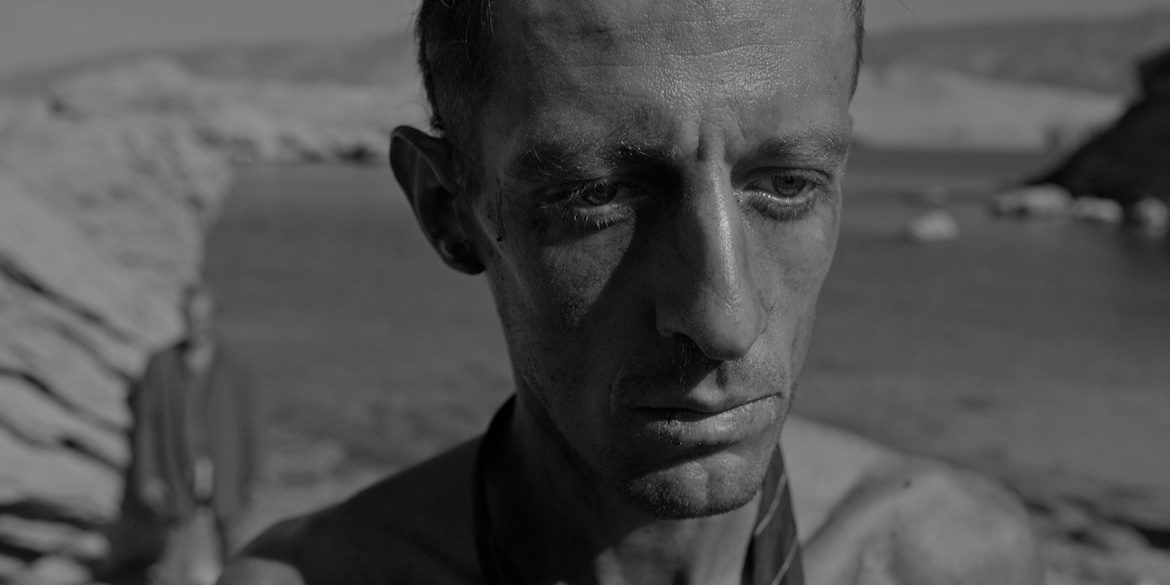Laura Arís Álvarez (Geometrija daha): „More oko nas je isto, a temelji zajednički”
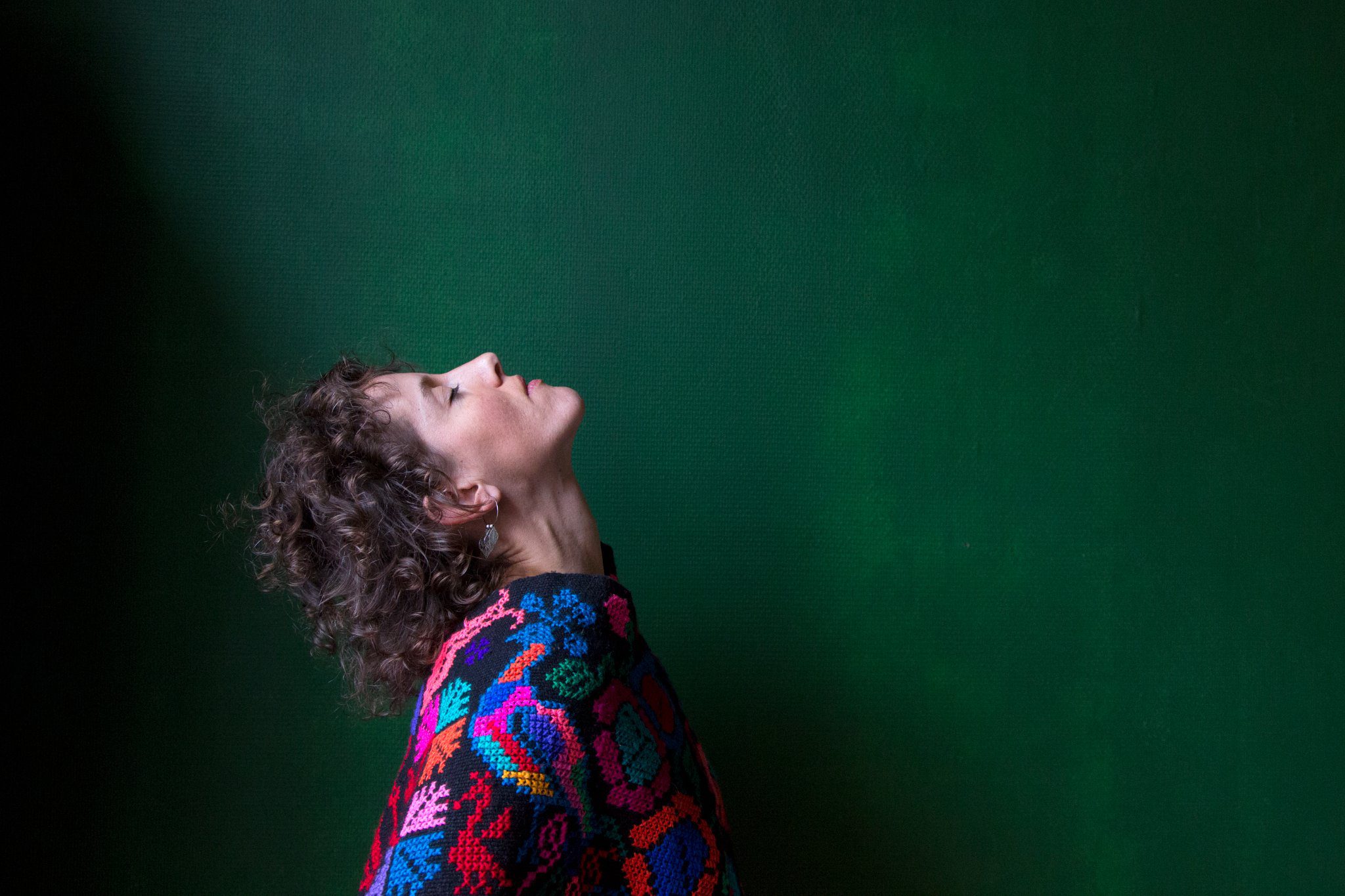
Nakon živopisnih ljetnih nastupa u Crnoj Gori, Izraelu, Dubrovniku i Hvaru, Zagrebački plesni ansambl novu je sezonu otvorio premijerno izvodeći plesnu predstavu španjolske koreografkinje Laure Arís Álvarez pod nazivom „Geometrija daha”.
Predstava je ovog ljeta djelomično prikazana na Festivalu plesa i neverbalnog kazališta, a nedavno je, dovršena i potpuno zaokružena, premijerno izvedena u Zagrebačkom kazalištu mladih. Izvodi ju mlada postava plesača Zagrebačkog plesnog ansambla koju čine Margareta Firinger, Andreja Jandrić, Luna Lilek, Endi Schrotter, Linda Tarnovski i Karlo Topolovec.
Nastala tijekom rezidencijalnih boravaka u španjolskoj La Factoriji i Mediteranskom plesnom centru u Svetvinčentu, „Geometrija daha”, uz posredstvo tijela u pokretu i njihovih sinergija, spaja temeljne oblike života – dah i sveprisutnu geometriju, tvoreći paradoks koji je, ironično, osnova svakog postojanja.
Ususret nadolazećim izvedbama koje će znatiželjne gledatelje upoznati s paradoksom kao jednim od osnovnih zakona prirode, razgovarali smo s Laurom Arís Álvarez, plesačicom, koreografkinjom i priznatom plesnom pedagoginjom koja nam je pobliže predstavila „Geometriju daha”.
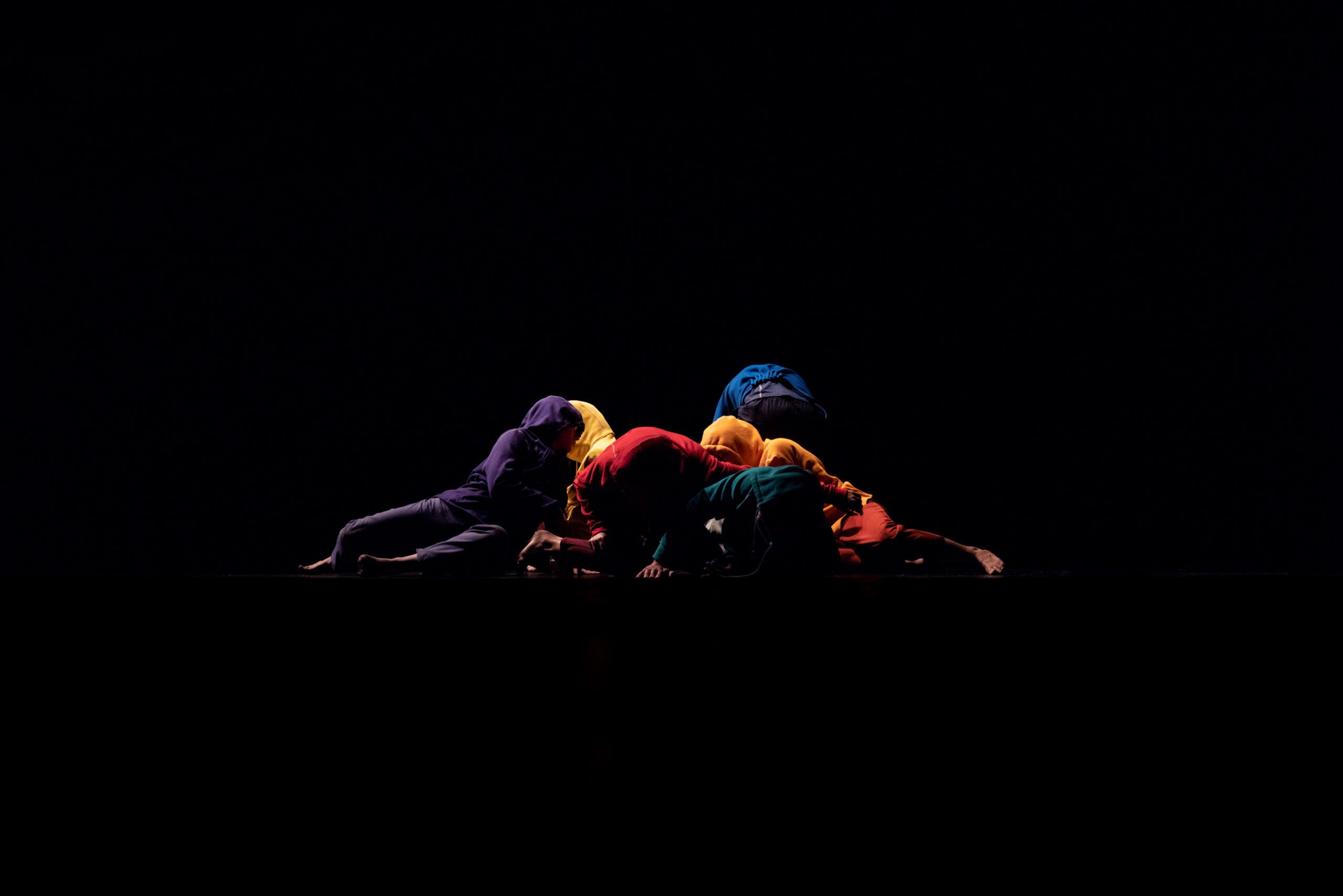
Riječi koje čine naslov predstave zvuče pomalo nespojivo. Kako se mogu povezati ne tako savršen oblik daha i savršena geometrija?
Zanimala me poetska napetost koju ovo uparivanje stvara. Dah je izravno povezan sa životom na Zemlji, a geometrija je povezana s matematikom i ljudskom željom za istraživanjem i razumijevanjem veličanstvenosti prirode u širem i kozmičkom smislu. Disanje je naš izvor energije, ono je život. Matematika je zastupljena posvuda. Klasična geometrija, utemeljena na racionalizmu, ovdje se može činiti ograničenom, ali fraktalna geometrija tjera vas da se zapitate. Kada, primjerice, pomislite na Fibonaccijev niz, brojevi sami po sebi nemaju pravo značenje, ali se stalno pojavljuju u matematici i prirodi. I, naravno, mogli bismo govoriti o sakralnoj geometriji, koja se može naći u mnogim civilizacijama diljem svijeta. Pojavljuje se u molekulama naše DNK, rožnici našeg oka, snježnim pahuljama, kristalima, zvijezdama, galaksiji unutar koje se spiralno vrtimo, zraku koji udišemo… A svi oblici života stvoreni su iz geometrijskih kodova.
Paradoks koji se krije u predstavi pokazuje da je čovjek istovremeno sve i ništa. Zašto ste odabrali baš tu temu i koje su vam misli prolazile kroz glavu dok ste stvarali koreografiju?
Pa, biti ono što jesi znači biti ono što postaješ, a onda postaješ i onda jesi ono što postaješ, iznova i iznova. U konačnici, ne postoji ništa za pronaći ili biti osim procesa pronalaženja i postojanja. Svaka stanica koja čini tijelo mijenja se svakih desetak godina. Konzistencija fizičkog tijela ionako nikad nije ista. Predstava nije o ljudskim bićima, već o postojanju svega oko nas i kako je sve povezano u neprestanoj transformaciji. Društvena smo bića i potrebna su nam druga bića da bismo preživjeli, ali također, primjerice, ovisimo o prirodnim resursima. Ovo je očita istina, ali još uvijek postoji tendencija da se kao entiteti odvojimo od svega ostalog.
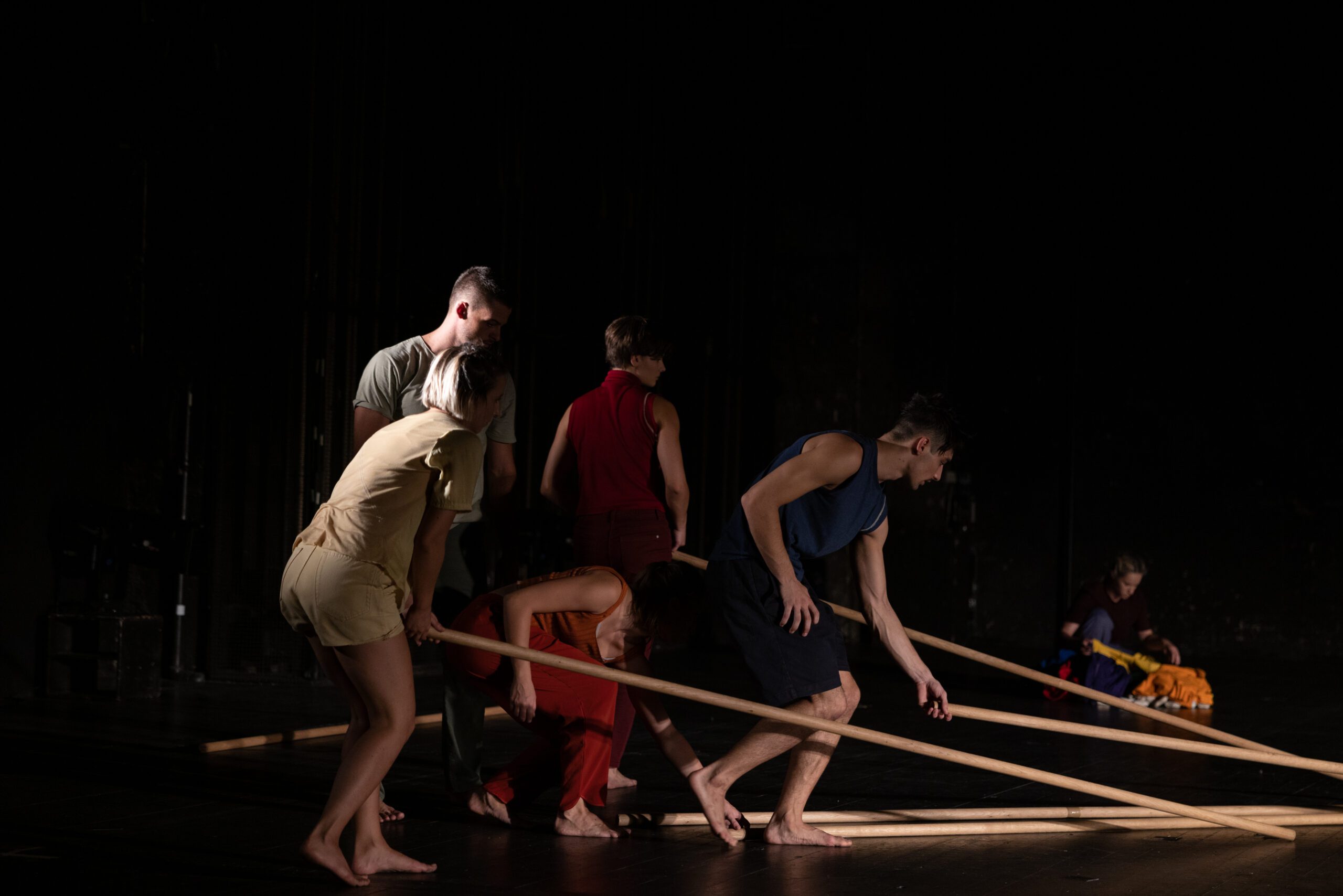
Htjela sam napraviti predstavu o prirodi, konceptualno je dovesti na pozornicu i odati joj počast. Tijekom samostalnog rada prije proba s plesačima, dvije su knjige bile izvori informacija i nadahnuća: „A Beautiful Question”, fizičara Franka Wilczeka i „The Forest Unseen”, biologa Davida G. Haskella. S prvom sam shvatila da je jedan od lajtmotiva prirode „promjena bez promjene” (i njezina ekonomija sredstava), kao i da je središnja teorija koja upravlja domenama prirodnih znanosti duboko ukorijenjena u konceptima simetrije (harmonija, ravnoteža i proporcija) i geometrije. Simetrije se također promatraju u kvantnoj fizici kroz pravila slična zvuku ili glazbi.
Za ovu predstavu, posudila sam znanstvene podatke kao pokretački naboj koji je navike moje mašte pretvorio u poetska područja i scenske slike. Moderna nam znanost govori o iznimnom rasponu međuodnosa. Ne možemo zanemariti da je more oko nas isto i da su nam temelji zajednički.
Kako plesači egzistiraju na pozornici s obzirom na temu koja naglašava da su dio svijeta/prirode i da nemaju apsolutnu slobodu?
Plesačima sam od prvog dana govorila da će to biti zborski nastup i da će se stalno morati baviti unutarnjom grupnom dinamikom i zajedno rješavati probleme. Mnogo je kolektivnih improvizacija unutar okvira koreografske strukture, što je psihički zamorno jer od svakog plesača zahtijeva puno koncentracije, velikodušnosti i slušanja tijekom cijele predstave. Rekla sam im da se ne radi o njima kao pojedincima, nego o tom jednom kolektivnom tijelu, poput redovnika koji razrađuju mandalu. Koncentracija uključena u njenu izradu, ravnoteža između složenosti i koherentnosti, kao i svih simbola u predstavi (promjena života i kozmosa) i, iznad svega, njen prolazni karakter.
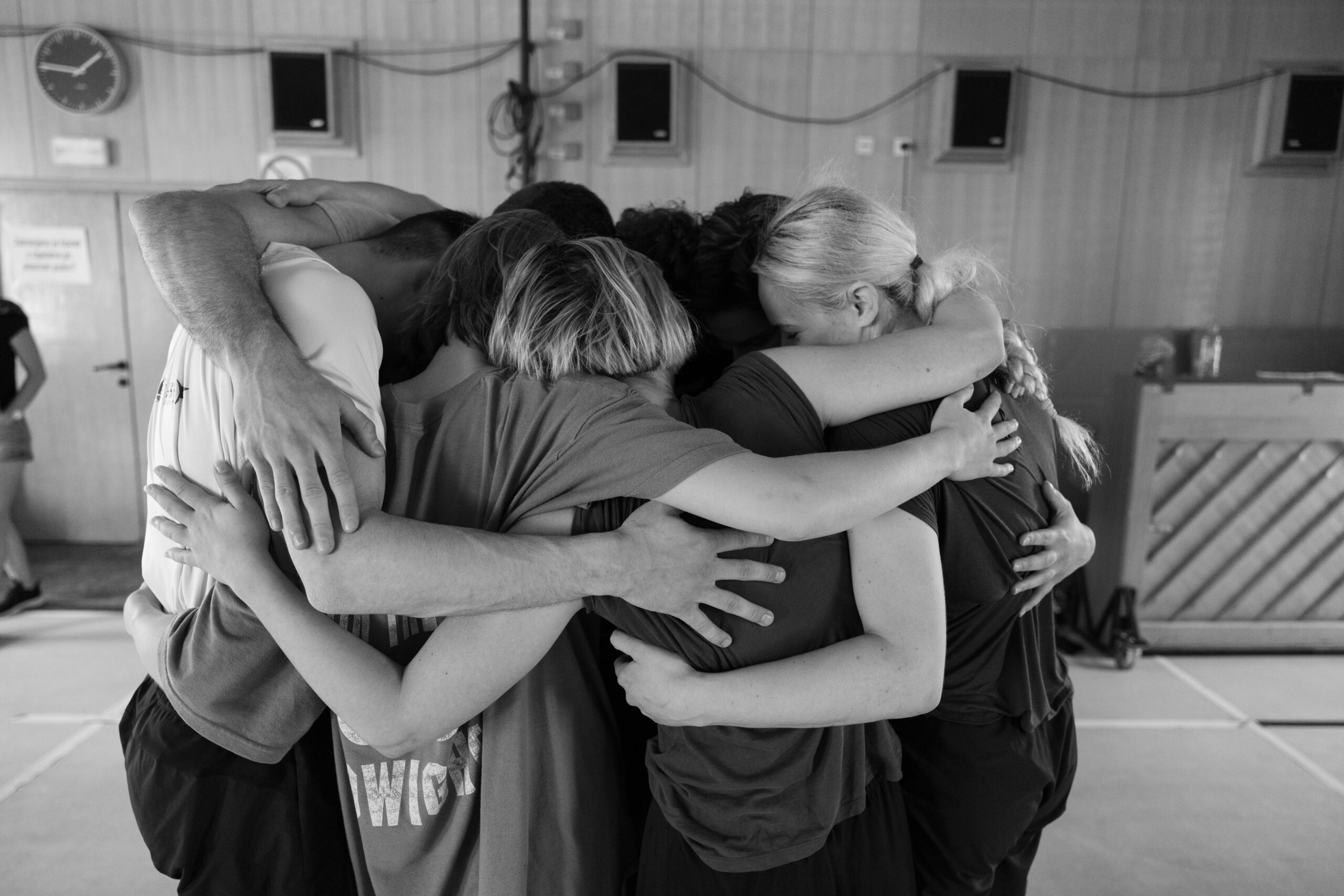
Kako su motivi gravitacije i želja za visinom utkani u izvedbu?
Jedna od rečenica na pozornici glasi: „Hijerarhija gravitacije ići će svojim tijekom, a mi ćemo se konačno rastopiti u elementima”.
Zarobljeni smo u njezinom polju djelovanja, živimo potpuno prepušteni njezinim učincima, a fizičari tek trebaju u potpunosti dešifrirati što je gravitacija. Sva živa bića konfigurirana su pokoravajući se njezinim zakonima: biljke spuštaju svoje korijenje prema podzemlju u potrazi za hranjivim tvarima, a životinje i ljudi konfigurirali su svoj krvni, probavni, mišićni i koštani sustav u skladu s ograničenjima ili prednostima koje pruža ta sila. Planeti su grupirani u sustave eliptičnih orbita zbog ispreplitanja sila koje oblikuju njihova gravitacijska polja. Gravitacija pokreće procese kao što su stvaranje zvijezda, pojava planeta ili kolaps crnih rupa… A ipak je gravitacija najslabija od četiriju sila koje upravljaju kozmosom. To je fascinantno!
Kao plesači, neprestano pokušavamo unaprijediti način na koji koristimo gravitaciju, a zatim i želju da se borimo protiv nje, uživajući u neizmjernom zadovoljstvu da je zadirkujemo, kao što to čine ptice. Postoje tri objekta koja se koriste tijekom predstave, a načini na koje rabimo svaki od njih različito se bave gravitacijom. Neću vam previše otkriti o tome; morat ćete doći pogledati predstavu i istražiti sami.
Možete li na primjeru svoje koreografije objasniti kako tijela u pokretu uvijek stvaraju vrijednosti veće od ukupnog zbroja pojedinačnih elemenata?
Iako se tijekom izvedbe pojavljuju različite scene, predstava teče poput meditacije, snenog, počasnog i hipnotičkog odlomka. To se događa zahvaljujući koreografskoj strukturi, zvučnoj kulisi, korištenju prostora, kostimima i dizajnu svjetla. Međudjelovanje i suradnja svih ovih stvari proizvode kombinirani učinak veći od zbroja njihovih zasebnih učinaka.
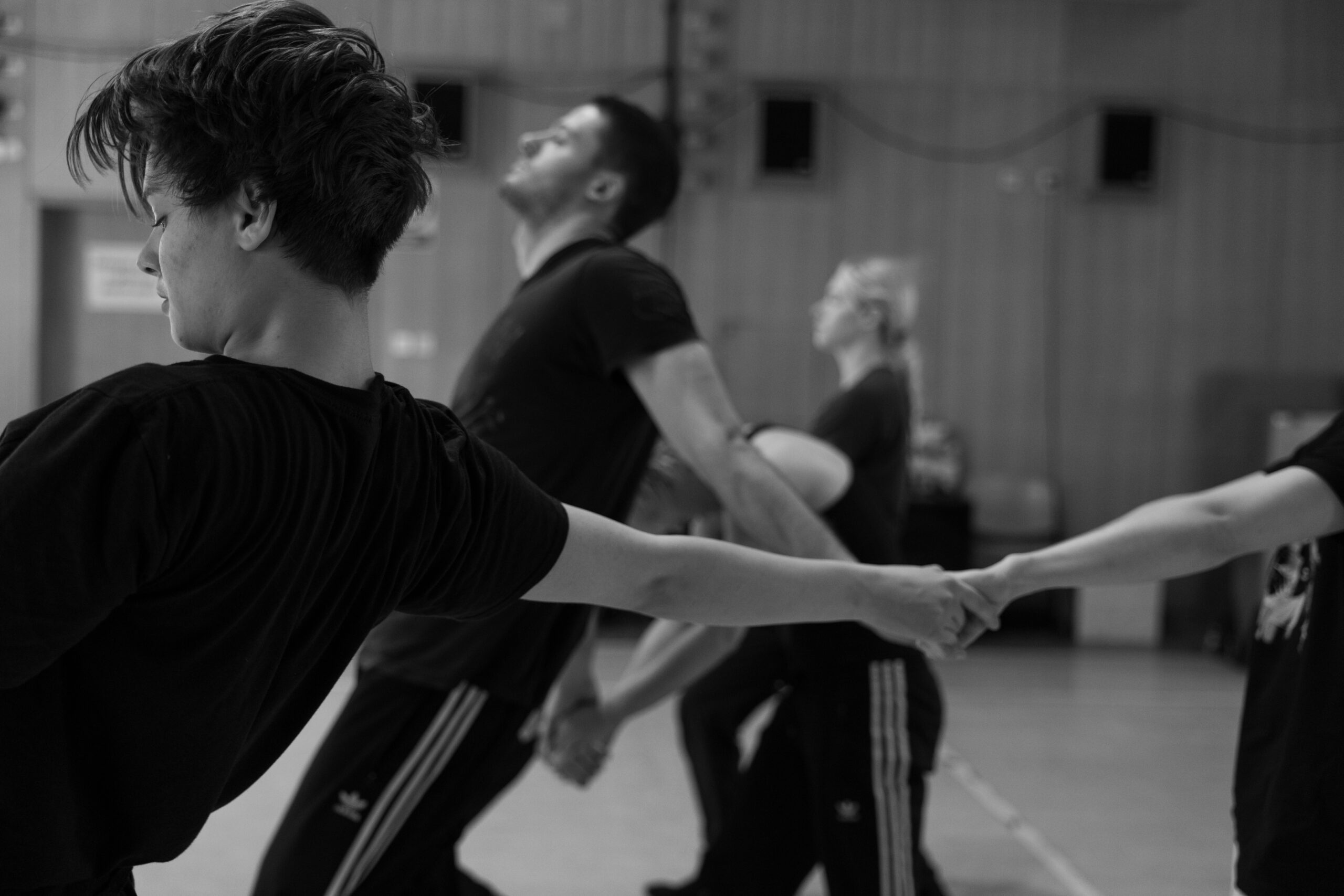
Kojim ste se principima vodili pri stvaranju koreografije?
Kao što sam rekla, posudila sam znanstvene podatke (pojmove, riječi, slike, itd.) kao inspiraciju i prevela ih na scenski jezik. Osim rada na gravitaciji, prostoru i vremenu, pokušavala sam istražiti spektar vidljive svjetlosti – segment elektromagnetskog spektra koji ljudsko oko može vidjeti. Kostimi i način na koji ih koristimo, kao predmete svjetla i boje, bili su jedan od mojih ciljeva i veliki izazov.
Koliko vam je bliska poruka predstave?
Pa, polazište ove kreacije ima intimno i osobno značenje, a tu moram spomenuti dvije godine pandemije. Suočila sam se s nemogućnošću rada i putovanja (što je u mom životu gotovo isto), a također je bilo teško pronaći besplatne ili otvorene plesne studije za nastavak rada (ili treniranja). Tako sam isprva bila prisiljena trenirati u šumi — po kiši, snijegu, dnevnom svjetlu ili čak u mraku zimskih večeri. Međutim, s vremenom je to postao osobni izbor, koji nastavljam prakticirati u kombinaciji sa studijskim radom. Dakle, biti u svakodnevnom kontaktu i promatrati istu šumu tijekom promjene godišnjih doba postalo je bitan dio mog razmišljanja. Tijekom tog razdoblja, i ovog osobnog iskustva, počela sam pisati svoje prve bilješke o „Geometriji daha” koja se u početku zvala „Dah zvijezda zauzima moje tijelo”.
Što mislite, kakve će emocije predstava izazvati kod publike i po čemu biste voljeli da ostane u sjećanjima?
Predstava je zamišljena i kreirana kao oblik meditacije, šetnje kroz kozmički san, oniričan i izazovan. Gdje je prisutna ljepota, ali i surovost prirode. Želimo pridonijeti usporavanju užurbanog gradskog načina života većine nas i pozvati publiku da se uključi u kontemplativni način i dopusti si da sjedne, postane dio toga i uživa u predstavi.
Izvorni tekst
After vivid summer performances in Montenegro, Israel, Dubrovnik and Hvar, the Zagreb Dance Ensemble opened the new season by premiering a dance show by Spanish choreographer Laura Arís Álvarez entitled „Geometry of Breath”.
The play was partially shown this summer at the Dance and Non-Verbal Theater Festival, and recently, completed and fully rounded, it premiered at the Zagreb Youth Theater. It is performed by a young line-up of dancers from the Zagreb Dance Ensemble consisting of Margareta Firinger, Andreja Jandrić, Luna Lilek, Endi Schrotter, Linda Tarnovski and Karlo Topolovec.
Created during residencies at the Spanish La Factoria and the Mediterranean Dance Center in Svetvinčent, „Geometry of Breath”, through the mediation of bodies in motion and their synergies, combines the fundamental forms of life – breath and ubiquitous geometry, creating a paradox that, ironically, is the basis of all existence.
Ahead of the upcoming performances that will introduce curious viewers to the paradox as one of the basic laws of nature, we talked to Laura Arís Álvarez, a dancer, choreographer and recognized dance pedagogue who introduced us in more detail to the „Geometry of Breath”.

The words that make up the title of the play sound a bit incompatible. How can breathing and perfect geometry be connected?
I was interested in the poetic tension that this pairing creates. Breath is directly related to life on earth, and Geometry is related to mathematics and the human quest to explore and understand the magnificence of Nature in a broad and cosmic sense.
Breathing is our source of energy: it’s life. Mathematics expresses itself everywhere. Classical geometry, based on rationalism, might seem more limited here, but fractal geometry makes you wonder. When you think of the Fibonacci sequence, for example, the numbers by themselves have no real meaning, but they appear all the time in mathematics and nature. And, of course, we could talk about Sacred geometry, which can be found in many civilizations worldwide. It appears in the molecules of our DNA, the cornea of our eye, snowflakes, crystals, the stars, the galaxy we spiral within, the air we breathe, and all life forms are created out of geometric codes.
The paradox hidden in the performance aims to show that a human being is everything and nothing at the same time. Why did you choose that topic, and what thoughts were going through your head while creating the choreography?
Well, being who you are is being whom you become, and then you become and then being whom you become, over and over. In the end, there is nothing to find or be but a process of finding and being. Every cell that composes the body is replaced every ten years or so. Then the consistency of the physical body is never the same anyway.
The show is not about human beings but about the existence of everything around us and how everything is connected in constant transformation. We are social beings, and we need other beings to survive, but we also, for example, depend on natural resources. This is an obvious truism, but there is still a tendency to separate ourselves as entities from everything else.

I wanted to make a show about nature, to bring it conceptually on stage and dedicate a tribute to it. During the table work before rehearsals with the dancers, two books were sources of information and inspiration: „A Beautiful Question” by the physicist Frank Wilczek and „The Forest Unseen” by biologist David G. Haskell. With the first, I understood that one of the leitmotifs of nature is “change without change” (and its economy of means), as well as that the central theory governing the domains of the natural sciences is deeply rooted in the concepts of symmetry (harmony, balance, and proportion) and geometry. Symmetries are also observed in quantum physics through rules similar to sound or music.
For this show, I have borrowed scientific data as a propelling charge that has broken the habits of my imagination into poetic realms and scenic images. Modern science tells us of an extraordinary range of interrelationships. We cannot ignore that the sea around us is the same and that our foundations are shared.
How do the dancers exist on the stage considering the theme that emphasizes that human beings are part of the world/nature and do not have absolute freedom? What are their movements and emotions?
I told the dancers from the first day that it would be a choral performance and that they would have to constantly deal with the inside group dynamics and solve problems together. There are many collective improvisations within the internal choreographic structure’s frame, which is mentally tiring as it requires a lot of concentration, generosity, and listening from every dancer during the entire show.
I told them it was not about them as individuals, but about that one collective body, like monks elaborating a mandala. The concentration involved in making it, the balance between complexity and coherence, as well as all the symbols in the show (the change of life and the cosmos) and, above all, its ephemeral character

How are the motives of gravity and the desire for height related to the performance? How do the dancer’s bodies vary between these two opposites?
One of the texts on stage says: „The hierarchy of gravity will take its course, and we will finally dissolve into the elements”.
We are trapped in its field of action, we live entirely surrendered to its effects, and yet physicists have yet to decipher completely what gravity is! All living beings have been configured to obey its laws: plants throw their roots toward the subsoil to look for nutrients, and animals and humans have configured their blood, digestive, muscular, and skeletal systems according to the limitations or advantages provided by this force. The planets are grouped in elliptical orbit systems due to the interweaving of forces that shape their gravitational fields; Gravity triggers processes such as the formation of stars, the appearance of planets, or the collapse of black holes…And yet gravity is the weakest of the 4 forces governing the cosmos. It’s amazing!
As dancers, we constantly try to refine the use we give to gravity and then the desire to fight it, enjoying the immense pleasure of teasing it, as birds do. There are three different objects used during the show, and the use we give to each of them deals with gravity in very different ways. I won’t tell you more about it; you’ll need to come to see the show and check it out.
Using the example of your choreography, could you explain what it means that bodies in motion are always a possibility of synergy, i.e. that they create values greater than the total sum of the individual elements?
Although there are different scenes during the performance, the show flows like a meditation, a dreamy, honorific, and hypnotic passage. This happens thanks to the choreographic structure, the soundscape, the use of space, the costumes, and the lighting design. The interaction and cooperation of all these things produce a combined effect greater than the sum of their separate effects.

What principles guided you when creating the choreography, and how do you describe it now? Did you encounter any challenges and difficulties when creating the concept?
As I said, I borrowed scientific data (concepts, words, images, etc.) as inspiration and translated it into a stage language. Besides working on gravity, space, and time, I try to explore the visible light spectrum: which is the segment of the electromagnetic spectrum that the human eye can view. The costumes and the use we give to them – as objects of light and color – were one of my goals and a big challenge.
How close is the message of the play to you, and which elements of the choreography would you mention as the best representatives of the main idea of the performance? What were you looking for from the dancers on stage?
Well, the starting point of this creation has an intimate and personal meaning, and here I must mention the two years of the pandemic. I faced the impossibility of working and traveling (which in my life are almost the same thing), but finding free or open dance studios to continue working (or training) was also tricky. So at first, I was forced to train in the forest – in the rain, snow, daylight, or even in the darkness of winter evenings.
However, over time it became a personal choice, which I continue to practice in combination with studio work. So being in daily contact and observing the same forest during the change of seasons became an essential part of my rumination, and it was during that period, and this personal experience, that I started to write my first notes on „Geometry of Breath”; which at the beginning was called: „The Breath of the Stars Occupies my Body”.
What emotions do you think the performance will evoke in the audience, and how would you like them to remember the performance?
The show is conceived and created as a form of meditation, a walk through a cosmic dream, oneiric and evocative. Where beauty is present but also the harshness of nature. We want to contribute to slowing down the hectic city lifestyle of most of us and invite the audience to engage in a contemplative mode and allow themselves to sit, be a part of it and enjoy the show.
Ovaj je sadržaj sufinanciran sredstvima Fonda za pluralizam medija Agencije za elektroničke medije.


